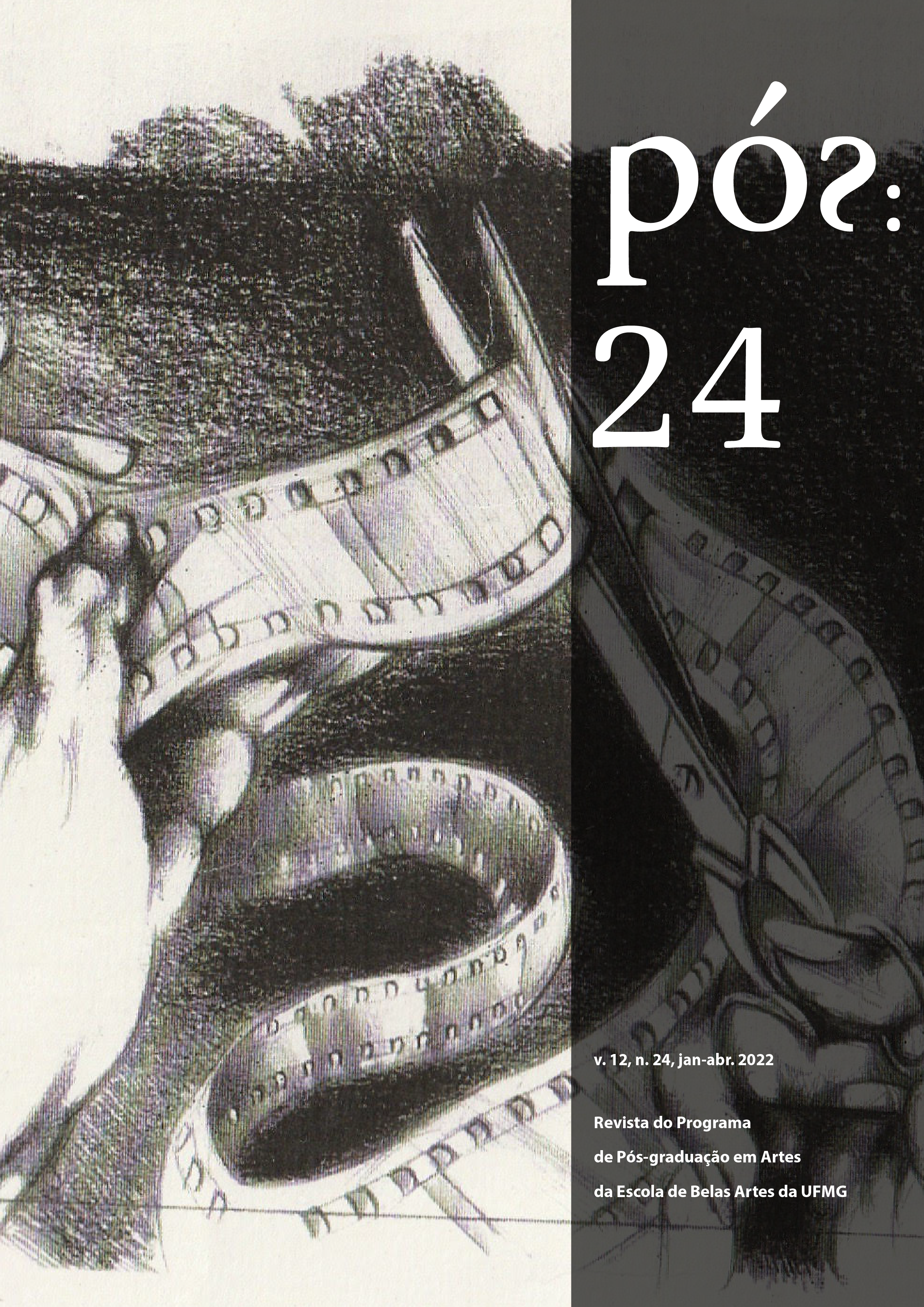Faced with the film
analysis as a translation of an audiovisual thought
DOI:
https://doi.org/10.35699/2237-5864.2022.37097Keywords:
filmmakers theory, logopathic signs, film analysis, film theory, Formativity AestheticsAbstract
An analysis is a method that divides a whole into parts for its understanding. Likewise, film analysis separates elements and components of the film system to arrive at the meanings and effects produced. The analysis itself (interpretation and meaning of these data) varies according to the theoretical assumptions and the intention of the analysis. However, recurrently, the film is reduced to the illustration of theories. We seek to trace a possible path of interference in this state of affairs from authors who address the issues of film investigation not as an illustrative object of theory but as a form of audiovisual thought, and we propose the posture of the person who analyzes the film as a translator of the audiovisual experience for the verbal.
References
ABDO, Sandra. Sobre o problema da autonomia da arte e suas implicações hermenêuticas e ontológicas. Revista Kriterion, Belo Horizonte, v. 46, n. 112, dez. 2005. <https://doi.org/10.1590/S0100-512X2005000200018>. Acesso em: 18 fev. 2022.
ANDREYEV, Leonid. First letter on theatre (extracts). In: TAYLOR, Richard; CHRISTIE, Ian (ed.). The filmfactory: Russian and Soviet cinema in documents – 1896-1939. Translated by Richard Taylor. London: Routledge, 1994. p. 27-31.
ANDREW, J. Dudley. As principais teorias do cinema: uma introdução. Tradução de Teresa Ottoni. Rio de Janeiro: Jorge Zahar, 1989.
AUMONT, Jacques. As teorias dos cineastas. Tradução de Marina Appezeller. Campinas, SP: Papirus, 2004. (Coleção Campo Imagético).
AUMONT, Jacques. Pode um filme ser um ato de teoria? Educação & Realidade, v. 33, n. 1, p. 21-34,jan./jun. 2008. Disponível em: <https://seer.ufrgs.br/educacaoerealidade/article/view/6684>. Acesso em: 3 jul. 2021.
BORDWELL, David; THOMPSON, Kristin. A arte do cinema: uma introdução. Tradução de Roberta Gregoli. Campinas, SP: Editora UNICAMP; São Paulo, SP: Edusp, 2013.
CABRERA, Julio. Cine: 100 años de filosofía: una introducción a la filosofía a través del análisis de películas. Barcelona: Editorial Gedisa, 2015. E-book.
CABRERA, Julio. Cine: 100 años de filosofía: una introducción a la filosofía a través del análisis de películas. Barcelona: Gedisa, 2002.
CANUDO, Ricciotto. Manifiesto de las Siete Artes. In: RAMIÓ, Joaquim Romaguera i; THEVENET, Homero Alsina (Ed.). Textos y manifiestos del cine; estética. escuelas. movimientos. disciplinas. innovaciones. 3. ed. Madrid: Catedra, 1998. (Signo e Imagem). p. 15-18.
CARREIRO, Rodrigo. Apontamentos sobre a análise fílmica. In: _____. A linguagem do cinema: umaintrodução. Recife: Editora UFPE, 2021. E-book. p. 217-235.
CHATEAU, Dominique. Estética del cine. Buenos Aires: La Marca Editora, 2010.
ECO, Umberto. Lector in fabula. São Paulo: Perspectiva, 1979a.
ECO, Umberto. Obra aberta. São Paulo: Perspectiva, 1979b.
ECO, Umberto. Seis passeios pelos bosques da ficção. São Paulo: Companhia das Letras, 1994.
EDISON, Thomas Alva. Preface. In: DICKSON, W.K.L.; DICKSON, Antonia. History of the Kinetograph and kinetophonograph. New York: MOMA, 2000. p. 3. (Facsimile Edition).
GARDIES, René (org.). Compreender o cinema e as imagens. Tradução de Pedro Elói Duarte. Lisboa: Texto & Grafia, 2008. (Mi.Mé.Sis, Artes e Espetáculo, 2).
GATTI, F. L. O. A formação da obra de arte como pesquisa: formatividade e metodologia em processos criativos. PÓS: Revista do Programa de Pós-graduação em Artes, Belo Horizonte, v. 8, n. 15, p. 140-155, 2018. Disponível em: <https://periodicos.ufmg.br/index.php/revistapos/article/view/15603> Acesso em: 12 ago. 2021.
GORKI, Maxim. The Lumière Cinematograph (extracts). In: TAYLOR, Richard; CHRISTIE, Ian (ed.). The film factory: Russian and Soviet cinema in documents – 1896-1939. Translated by Richard Taylor. London: Routledge, 1994. p. 25-26.
GRAÇA, André Rui; BAGGIO, Eduardo Tulio; PENAFRIA, Manuela. Teoria dos cineastas: uma abordagem para a teoria do cinema. Revista científica FAP, Curitiba, v. 12, p. 19-32, jan./jun. 2015. Disponível em: <http://periodicos.unespar.edu.br/index.php/revistacientifica/article/viewFile/1408/762> Acesso em: 12 ago. 2021.
MARIE, Michel. Prefácio. In: GARDIES, René (org.). Compreender o cinema e as imagens. Tradução de Pedro Elói Duarte. Lisboa: Texto & Grafia, 2008. (Mi.Mé.Sis, Artes e Espetáculo, 2).
MICHAUD, Philippe-Alain. Filme: por uma teoria expandida do cinema. Tradução de V. Ribeiro. Rio de Janeiro: Contraponto, 2014.
MOTA, Marcus. Luigi Pareyson e a análise da experiência estética: do pensar o pensamento para o pensar o fazer. In: ENCONTRO NACIONAL da ANPAP, 13., Brasília, 2004. Disponível em: <https://www.academia.edu/15609374/Luigi_Pareyson_e_a_an%C3%A1lise_da_experi%C3%AAncia_est%C3%A9tica_do_pensar_o> Acesso em: 07 jul. 2021.
PASOLINI, Pier Paolo. Empirismo Hereje. Lisboa: Assírio e Alvim; Edição 152, 1982.
RAMOS, Fernão Pessoa. Apresentação à edição brasileira. In: JULLIER, Laurent; MARIE, Michel. Lendo as imagens do cinema. Tradução de Magda Lopes. São Paulo: Editora Senac São Paulo, 2009. p. 9-13.
SAMAIN, Etienne. As imagens não são bolas de sinuca. Como pensam as imagens. In: _____. (org.). Como pensam as imagens. Campinas, SP: Editora Unicamp, 2012. p. 21-36.
SAVERNINI, Erika. Cinema utópico: a construção de um novo homem e um novo mundo. 2011. 283f. Tese (Doutorado em Artes e Cinema) – Escola de Belas Artes, Universidade Federal de Minas Gerais, Belo Horizonte, 2011.
SAVERNINI, Erika. Índices de um cinema de poesia: Pier Paolo Pasolini, Luis Buñuel e Krzysztof Kieslowski. Belo Horizonte: Editora UFMG, 2004.
STAM, Robert. Introdução à teoria do cinema. Tradução de Fernando Mascarello. Campinas, SP: Papirus, 2003. (Coleção Campo Imagético).
XAVIER, Ismail (org.). A experiência do cinema: antologia. Rio de Janeiro: Graal; Embrafilme, 1983. (Coleção Arte e Cultura, 5).
XAVIER, Ismail. O discurso cinematográfico: a opacidade e a transparência. 4. ed. São Paulo: Paz & Terra, 2008.
Downloads
Published
How to Cite
Issue
Section
License
Copyright (c) 2022 Erika Savernini

This work is licensed under a Creative Commons Attribution-NonCommercial 4.0 International License.
Authors who publish in this journal agree to the following terms:
- Authors retain copyright and grant the journal the right of first publication, with the work simultaneously licensed under the a Creative Commons Attribution-NonCommercial 4.0 International License that permits sharing of the work with acknowledgement of authorship and initial publication in this journal;
- Authors are permitted to enter into additional contracts separately, for non-exclusive distribution of the version of the work published in this journal (e.g., the Creative Commons Attribution License).
- Authors are permitted and encouraged to publish and distribute their work online (e.g., in institutional repositories or on their home page) at any point before or during the editorial process, as this may generate productive changes as well as increase the impact and citation of the published work.
- It is the responsibility of the authors to obtain written permission to use in their articles materials protected by copyright law. Revista PÓS is not responsible for copyright breaches made by its contributors.












